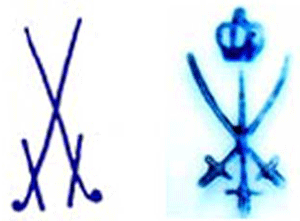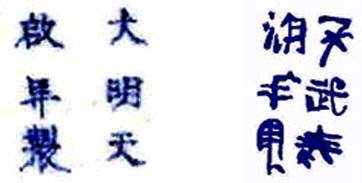|
Fake or Real? Tell-tale Signs on Reproduction Porcelain
I bet you have asked this question hundreds of times when strolling through your favorite antiques fair and as you pick up a beautiful porcelain figurine: is it fake? You check the backstamp with deep concern. It looks familiar, but not quite. Now you are even more confused. “Marks are supposed to tell me the maker and its age,” you murmur as you go on to the next stall with a sense of loss for a true treasure. But you liked it! It was such a bargain!
You are not alone. Most importantly, this is not a new phenomenon. Reproductions have been made and sold in droves at all times. It’s almost as old as Rome copying Greek art and as new as the most recent Asian imports. In fact, Chinese reproductions were first copied and imitated, including using fake Kanji marks (Chinese symbols), by Europeans since the 15th century until well into the 20th century. In reverse, Asian reproductions of European porcelain had their peak for a brief period around the 1960s to the 1990s. Now, it is the Chinese themselves who are reproducing their old traditional wares. Go figure, or as you might say, “Follow the money.”
|

|
An authentic Meissen mark used ca. 1860-1924 (l.) vs. a fake Chinese mark on reproductions ca. 1990s to present.
|
In other words, what is popular and sells well will be imitated and reproduced in large numbers. Call it flattery if you wish, but in essence, reproductions follow trends just like any other product, and that’s a good thing. For instance, what was considered a local reproduction or inferior copy of a Chinese porcelain masterpiece made by Meissen in Germany circa late 18th century is now antique and very valuable. Same with Delftware or Sevres or even Staffordshire Chinoiserie pieces from the 18th to 19th centuries. So the key is not whether it’s a fake, but how new of a fake it is. Welcome to the world of Grand Recycling of Art through the ages. That porcelain figurine you almost bought at the antiques fair will be very valuable to your great-great-grandkids.
|

|
(L.)A Ming Dynasty Tianqi mark, ca. 1620-1627 (also seen on recent Chinese copies) versus an authentic ca. 1720s Meissen mark (r.) using Kanji characters to gain market acceptance at a time when Chinese porcelain imports were more popular.
|
But you are selfish and don’t want to think about generations you won’t even meet. So although you accept that just about anything you see is most likely some kind of a reproduction of a bygone era, you need to know if it’s considered antique right now. You wish there was some way of telling on the spot, or at least be able to decipher those darn marks and get a glimpse of its journey to now. Age matters, and time is short.
Today is a good day. Here are some rules of thumb to arm yourself for your next antiquing adventure:
- If the mark is too perfect, it is new. Most older maker’s marks were stamped by hand using ink and show signs of partial fading or are a bit crooked. New marks are printed using industrial ink-jet printers and are very sharp or clear.
- If the mark is hand-drawn, check its shape and what surrounds it. If it resembles old familiar marks of Meissen, Sevres and the like but is a bit too embellished, it’s probably a fake. If also shown with an old date or a model number, it’s probably recent.
- Examine for “true” signs of aging—these can be faked. Crazing can be artificially induced by varying the temperature in the kiln. “Oldness” can be imitated by applying sepia-like glazes. Instead, try to see how uniform these signs are. If too uniform and all over, the item is probably a new reproduction. If the piece is slightly damaged, find an old chip or tiny break and check the difference between the exposed area against the rest of its body; there should be a distinct difference in brilliance if authentic.
- Be an art critic and pay attention to its detailed features. Check for workmanship and hints of real talent. Older pieces were produced by hand, one at a time. The modeler masterfully created each component with care and uniqueness. Each hand, each face, each flower—all were made separately and then assembled together before firing in the kiln as one piece. The faces are expressive. Newer reproductions use the same face or head, the same arms or legs and the same three or four kinds of flowers that are finally assembled in many versions of a theme. They just splash on some different colors or a hairdo or lipstick and other facial tones, and the final item suddenly acquires a gender, but it is basically made from a stock of ready-made identical parts produced by the thousands.
- Use the finger-and-toes test. Yes, you read that right. For reasons described above, older porcelain figurines seem to have their fingers delicately separate, and the toes (if visible) are distinct. Newer pieces tend to have these somewhat fused or attached to the body like small painted protrusions with no detailing. Some exceptions apply, especially on very small porcelain figurines.
For more specifics or for a particularly stubborn maker’s mark that doesn’t wish to reveal its age, check our database or ask our specialists.1
-------------------------------
1
Members of www.marks4antiques.com
can email the website’s experts as often as desired at no extra charge. Reference guides are available 24/7, even on smart phones.
Marks4antiques.com is currently celebrating its 10th anniversary of service. It is dedicated to providing the largest and most updated research tools to help its members identify and appraise antiques and collectibles. Registered members have access to comprehensive visual reference methods with thousands upon thousands of images of makers’ marks and hallmarks displayed in Shape or Letter Categories for fast access, or the proprietary Name or Initials Search features can be used. Also includes a huge database of millions of actual auction records and uses a “smart” search that quickly deciphers key terms using advanced software technology to yield accurate and relevant results. For more articles on this subject, see: www.marks4antiques.com/Reproductions-of-Chinese-antiques.htm
or www.marks4antiques.com/meissen-dresden-porcelain-marks.htm.
|